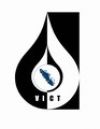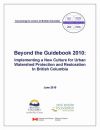Water Bucket provides "home" for telling the story of the Vancouver Island Coordinating Team

VICT is a grassroots coordinating team with representation from various jurisdictions and disciplines across Vancouver Island. Beyond building partnerships and strengthening local sustainability initiatives, VICT’s goal is to build local capacity for change.
Water Balance Model now resides within the 'Partnership for Water Sustainability in British Columbia', a non-profit society

“An essential part of the plan for ensuring the long-term sustainability of the Water Balance Model is the creation of a legal entity where the tool will reside permanently. This action has now been completed,” reports Ted van der Gulik. “Formation of the society is a pivotal milestone in the history of the WBM. Over the years, various people have asked us who owns the WBM. Now when we answer ‘the Partnership owns it’, it will be crystal clear to everyone.”
OKANAGAN 2010 FROM RAIN TO RESOURCE WORKSHOP: “The Water Balance Model allows the user to quickly establish the existing base line that will become the standard used to measure the performance of future development scenarios,” stated Jim Dumont

“The WBM embeds land use zoning from municipal member partners, soil calculator and a new calculation engine QUALHYMO utilizing the Environment Canada climate data that includes rainfall, snow, temperature and evaporation. The easy access and calculation speed combined with the embedded data and information allows the user to easily and effectively plan and design green infrastructure techniques which will achieve the vision and objectives established for the Site, the Development, or Watershed,” stated Jim Dumont.
Nature has Designed a Partnership between Land and Water, says landsape architect Peter MacDonagh

“These days we’re all hearing about ‘Green’, but few people realize to be really ‘Green’ you must be ‘Blue’ too! Nature has designed a partnership between land (‘Green’) and water (‘Blue’) where each benefits the other.” stated Peter MacDonagh.
The History of VICT

“Our Ministries decided to align our efforts and collaborate with DFO because we believe this will enable us to be collectively more effective in achieving desirable rainwater management outcomes,” stated Jay Bradley.
Water for Life & Livelihoods: The CAVI Model, as explained by Jay Bradley

Jay Bradley (120p)
A big part of what Convening for Action does is to create forums for dialogue, and to build collaborative partnerships towards a 50 year vision for Vancouver Island.
A GUIDING PRINCIPLE FOR INTEGRATED RAINWATER MANAGEMENT: Plan at Four Scales – Regional, Watershed, Neighbourhood and Site

“In integrating actions at four scales, the intended purpose is to provide a clear picture of how local governments can be proactive in applying land use planning tools to protect property and aquatic habitat, while at the same time accommodating land development and population growth,” states Kim Stephens.
Okanagan Rain to Resource Workshop: Ted van der Gulik presents the storyline for "Beyond the Guidebook 2010"

“Beyond the Guidebook 2010 demonstrates that the practitioner culture is changing as an outcome of collaboration, partnerships and alignment; and provides local governments with 'how to' guidance for developing outcome-oriented urban watershed plans,” states Ted van der Gulik. “The Guidebook recognized that water volume is something over which local government has control through its infrastructure policies, practices and standards.”
Bowker Creek Blueprint demonstrates what can be accomplished through a vision, alignment and collaboration

Jody Watson (120p)
The Bowker Creek Blueprint provides member municipalities, the CRD, the community and other land stewards with information and guidance to restore the watershed and creek corridor over the next 100 years.
Leading Change in British Columbia: "Beyond the Guidebook 2010" tells the stories of the champions

cover (364p x475p)
Beyond the Guidebook 2010
There is now a decade of experience from which to extract 'lessons learned' about how to move from awareness (interest) to action (practice). Outcome-oriented planning is a problem-solving PROCESS. It is not a procedure.

